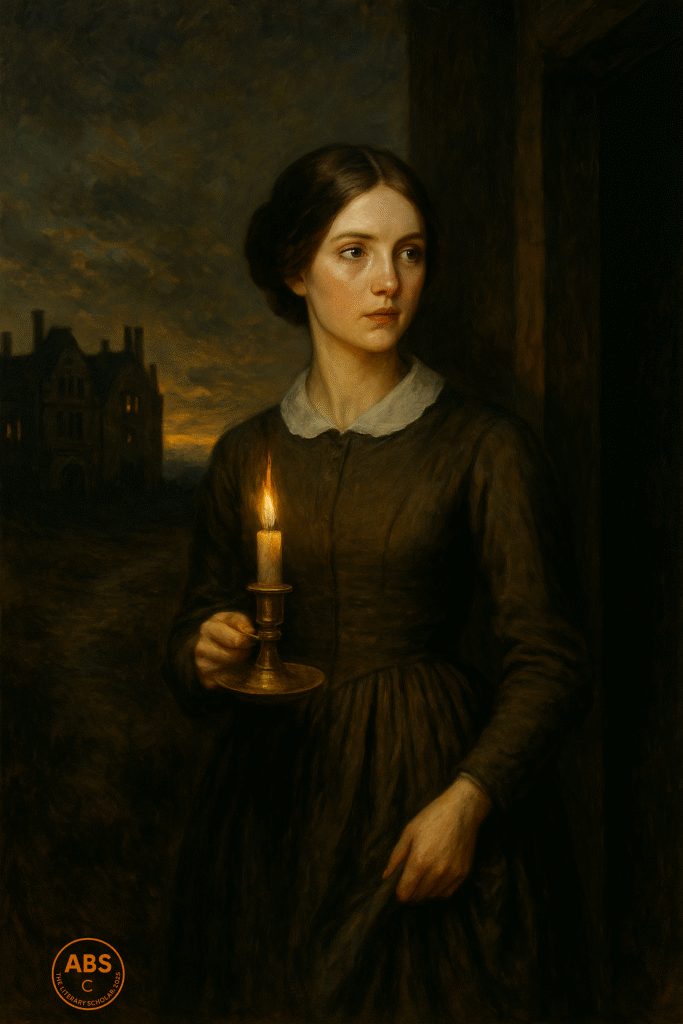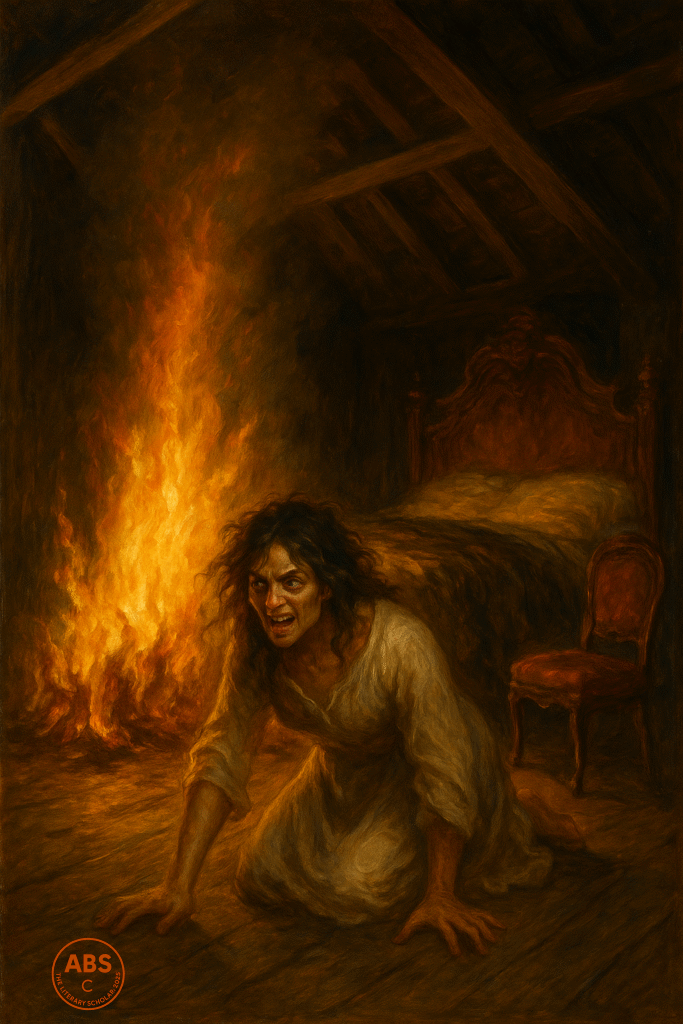By ABS, The Literary Scholar
(Who still wants to ask Jane Eyre, “Out of all the men in that mansion… him?”)
Once upon a moody English morning, a small, plain orphan named Jane Eyre decided she would not, under any circumstances, be silent, submissive, or spiritually gaslit by the patriarchy. And thus, Charlotte Brontë’s legendary novel Jane Eyre was born—a story that is part love letter, part ghost tale, part philosophical treatise, and part: What in the name of gothic fiction is going on in the attic?
Charlotte, the eldest of the Brontë brood, gave us a heroine who wasn’t dripping in charm or social graces but was instead carved out of conscience, fire, and the sort of moral integrity that could scare an entire boarding school staff into rethinking their punishment policies.
Jane: The Orphan Who Refused to Be Pitied
We begin in classic Brontë fashion—with suffering. Jane Eyre is orphaned, unloved, and emotionally waterboarded by her aunt and cousins at Gateshead. Her cousin John hits her, her aunt lies about her, and she’s shipped off to Lowood School, a charming little Victorian facility where the food is mouldy, the temperatures are sub-Arctic, and religious hypocrisy runs the cafeteria.
But Jane survives. She doesn’t become bitter—she becomes better. And when her childhood friend Helen Burns dies of typhus (yes, welcome to Chapter Tragedy), Jane doesn’t weep melodramatically. She watches. She learns. She grows into the kind of woman who can deliver a speech on equality and walk out of a house even when in love.
Enter Thornfield: Gothic, Grand, and Definitely Haunted
Now grown and slightly less emotionally frostbitten, Jane becomes a governess—the most socially awkward but narratively convenient job in all of Victorian fiction. She lands at Thornfield Hall, a moody mansion where everything creaks ominously and nobody seems concerned about the eerie laughter echoing down the corridors at night.
She meets Edward Rochester, a man who can only be described as a walking thundercloud with a superiority complex, a tragic backstory, and exactly zero small talk skills. He is brooding, mysterious, unpredictable, and, by every psychological measure, a red flag draped in Byronic poetry.
And Jane? She falls in love with him. Naturally.
“I am no bird; and no net ensnares me: I am a free human being with an independent will.”
Except… she does fall for a man who has locked his first wife in the attic, but we’ll get to that in a moment.
The Madwoman in the Attic: Victorian Horror or Domestic Metaphor?
Let’s not gloss over this: Rochester is keeping Bertha Mason, his first wife, hidden in the upper floor of the house like a Victorian skeleton in the closet—only with more screaming and occasional arson. She’s described as mad, animalistic, dangerous… a vision of what society feared most: a woman uncontrolled.
Critics have rightly side-eyed this narrative for centuries. Enter Jean Rhys, a 20th-century literary rebel who gave Bertha her voice back in Wide Sargasso Sea—a prequel that shows the “madwoman” as a tragic figure, colonially displaced, emotionally abandoned, and made insane by the very patriarchy that pretended to protect her.
So yes, Rochester is problematic. He gaslights Jane, proposes bigamy, and has the moral clarity of a foggy window. But for some reason, Jane still chooses him.
Why? Because Charlotte Brontë believed in the power of choice, even in messy circumstances.
The Wedding That Wasn’t
Just as Jane is about to marry Rochester (who conveniently fails to mention the attic tenant), the truth bursts into the chapel like a Brontëan plot twist on caffeine.
“The marriage cannot go on: I declare the existence of an impediment.”
Cue: gothic gasps, heartbreak, and the revelation that “Reader, I married him” was almost “Reader, I sued him.”
Jane does what few Victorian heroines dared—she leaves. Not in a flurry of tears, but with grace, backbone, and exactly the amount of drama required to preserve self-respect.
The Wandering, the Wuthering, and the Psychic Reunion
Jane ends up wandering the moors, collapsing into the arms of distant relatives (coincidence, thy name is Brontë). She gains an inheritance—because nothing says “moral triumph” like unexpected wealth—and politely declines the marriage proposal of St. John Rivers, a missionary whose idea of romance involves glaciers and guilt trips.
Meanwhile, back at Thornfield, Bertha has burnt the house down, leapt to her death, and Rochester—now blind and slightly scorched—lives in poetic ruin. Jane returns, and only then, after all the chaos, she finally marries him.
“To be together is for us to be at once as free as in solitude, as gay as in company.”
They are equal now. She chose him, not out of dependence or desperation, but love on her own terms.
Is It a Love Story or a Gothic Soap Opera?
Jane Eyre is not a love story in the traditional sense. It’s a survival story. A self-respect story. A “just because he’s brooding doesn’t mean he’s right” story.
Jane’s love isn’t blind—it’s battled for. She insists on her dignity. She teaches us that being in love doesn’t mean shrinking. And that sometimes, the real attic is the one society tries to trap you in.
Charlotte Brontë gave us a heroine who doesn’t sparkle—she burns. Quietly. Steadily. And with enough fuel to light up literary history.
Final Thoughts from the Gothic Drawing Room
The Brontë sisters, bless their tormented Yorkshire souls, didn’t write to please. They wrote to unsettle, to ignite, to haunt. Emily gave us the love that destroyed (Wuthering Heights), Anne gave us the love that walked away (The Tenant of Wildfell Hall), and Charlotte gave us the love that stood its ground (Jane Eyre).
In today’s world, Jane would probably run a successful podcast on boundaries and personal growth. Rochester would be in therapy, Bertha would sue for wrongful imprisonment, and St. John would still be drafting emotionally unavailable emails from a remote mission outpost.
ABS, the literary scholar, Extinguishes the candle in the attic, leaves a copy of Wide Sargasso Sea next to Rochester’s armchair, and walks out of Thornfield wearing boots made for independence—with a knowing smile that says, “Reader, I edited him.”)


Who knows that locking your wife in the attic is never a plot twist—it’s a lawsuit.
Still waiting for Bertha’s ghost to get the last word.
And believes love stories are better when the heroine owns the ending.
Signed
ABS
The Literary Scholar
Share this post / Spread the witty word / Let the echo wander / Bookmark the brilliance
